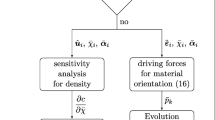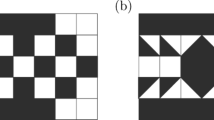Abstract
Modern high-performance materials have inherent anisotropic elastic properties. The local material orientation can thus be considered to be an additional design variable for the topology optimization of structures containing such materials. In our previous work, we introduced a variational growth approach to topology optimization for isotropic, linear-elastic materials. We solved the optimization problem purely by application of Hamilton’s principle. In this way, we were able to determine an evolution equation for the spatial distribution of density mass, which can be evaluated in an iterative process within a solitary finite element environment. We now add the local material orientation described by a set of three Euler angles as additional design variables into the three-dimensional model. This leads to three additional evolution equations that can be separately evaluated for each (material) point. Thus, no additional field unknown within the finite element approach is needed, and the evolution of the spatial distribution of density mass and the evolution of the Euler angles can be evaluated simultaneously.



















Similar content being viewed by others
Notes
In this previous publication we denoted the regularization parameter by \(\alpha \) and the viscosity for the compliance parameter by r instead of the present notations \(\beta _\chi \) and \(r_{\chi }\), respectively.
Employed software: ParaView. The isovolume filter displays every point of a given scalar as solid if its value ranges within a given interval. To display the density field in ParaView, we extrapolated the density values \(\rho = 1/f(\chi )\) within the Gaußpoints to the nodal points. Thus, the density value within a node between two neighboring Gaußpoint densities \(\rho = \{0,1\}\) will become 0.5, which matches the chosen isovolume filter.
References
Zhu JH, Zhang WH, Qiu KP (2006) Bi-directional evolutionary topology optimization using element replaceable method. Comput Mech 40(1):97–109. doi:10.1007/s00466-006-0087-0
Huang X, Xie YM (2008) Bi-directional evolutionary topology optimization of continuum structures with one or multiple materials. Comput Mech 43(3):393–401. doi:10.1007/s00466-008-0312-0
Rajan SD (1995) Sizing, shape, and topology design optimization of trusses using genetic algorithm. J Struct Eng 121(10):1480–1487. doi:10.1061/(ASCE)0733-9445(1995)121:10(1480)
Hajela P, Lee E, Lin C-Y (1993) Genetic algorithms in structural topology optimization. In: Topology design of structures. Springer, pp 117–133
Allaire G, Jouve F, Toader A-M (2004) Structural optimization using sensitivity analysis and a level-set method. J Comput Phys 194(1):363–393. doi:10.1016/j.jcp.2003.09.032. http://www.sciencedirect.com/science/article/pii/S002199910300487X
Xia Q, Wang MY (2008) Topology optimization of thermoelastic structures using level set method. Comput Mech 42(6):837–857. doi:10.1007/s00466-008-0287-x
Wang MY, Wang X, Guo D (2003) A level set method for structural topology optimization. Comput Methods Appl Mech Eng 192(1–2):227–246. doi:10.1016/S0045-7825(02)00559-5. http://www.sciencedirect.com/science/article/pii/S0045782502005595
Bourdin B, Chambolle A (2003) Design-dependent loads in topology optimization. ESAIM Control Optim Calc Var 9:19–48. doi:10.1051/cocv:2002070
Blank L, Garcke H, Sarbu L, Srisupattarawanit T, Styles V, Voigt A (2012) Phase-field approaches to structural topology optimization. In: Leugering G. et al. (eds) Constrained optimization and optimal control for partial differential equations. International Series of Numerical Mathematics, vol 160. Springer, Basel, pp 245–256
Harrigan TP, Hamilton JJ (1994) Bone remodeling and structural optimization. J Biomech 27(3):323–328
Kuhl E, Menzel A, Steinmann P (2003) Computational modeling of growth. Comput Mech 32(1–2):71–88
Waffenschmidt T, Menzel A (2012) Application of an anisotropic growth and remodelling formulation to computational structural design. Mech Res Commun 42:77–86
Bendsøe MP (1989) Optimal shape design as a material distribution problem. Struct Optim 1(4):193–202
Bendsøe MP, Sigmund O (1999) Material interpolation schemes in topology optimization. Arch Appl Mech 69(9–10):635–654
Rozvany G, Zhou M (1991) The coc algorithm, part i: cross-section optimization or sizing. Comput Methods Appl Mech Eng 89(1):281–308
Munk DJ, Vio GA, Steven GP (2015) Topology and shape optimization methods using evolutionary algorithms: a review. Struct Multidiscip Optim 52(3):613–631. doi:10.1007/s00158-015-1261-9
Deaton JD, Grandhi RV (2014) A survey of structural and multidisciplinary continuum topology optimization: post 2000. Struct Multidiscip Optim 49(1):1–38
Rozvany G (2009) A critical review of established methods of structural topology optimization. Struct Multidiscip Optim 37(3):217–237
Haber R, Pedersen P, Taylor J (1994) An analytical model to predict optimal material properties in the context of optimal structural design. Urbana 51:61801
Kočvara M, Stingl M (2007) Free material optimization for stress constraints. Struct Multidiscip Optim 33(4):323–335
Haslinger J, Kocvara M, Leugering G, Stingl M (2010) Multidisciplinary free material optimization. SIAM J Appl Math 70(7):2709–2728
Kočvara M, Stingl M, Zowe J (2008) Free material optimization: recent progress. Optimization 57(1):79–100
Nomura T, Dede EM, Lee J, Yamasaki S, Matsumori T, Kawamoto A, Kikuchi N (2015) General topology optimization method with continuous and discrete orientation design using isoparametric projection. Int J Numer Meth Eng 101(8):571–605
Stuelpnagel J (1964) On the parametrization of the three-dimensional rotation group. SIAM Rev 6(4):422–430
Blasques JP, Stolpe M (2012) Multi-material topology optimization of laminated composite beam cross sections. Compos Struct 94(11):3278–3289
Li S, Atluri S (2008) The mlpg mixed collocation method for material orientation and topology optimization of anisotropic solids and structures. Comput Model Eng Sci 30(1):37–56
Hvejsel CF, Lund E (2011) Material interpolation schemes for unified topology and multi-material optimization. Struct Multidiscip Optim 43(6):811–825
Zhou K-M, Li X (2006) Topology optimization of structures under multiple load cases using a fiber-reinforced composite material model. Comput Mech 38(2):163–170
Gea H, Luo J (2004) On the stress-based and strain-based methods for predicting optimal orientation of orthotropic materials. Struct Multidiscip Optim 26(3–4):229–234
Junker P, Hackl KA (2015) A variational growth approach to topology optimization. Struct Multidiscip Optim 52(2):293–304
Junker P, Hackl K (2016) A discontinuous phase field approach to variational growth-based topology optimization. Struct Multidiscip Optim 54(1):81–94
Jantos DR, Junker P, Hackl K (2016) An evolutionary topology optimization approach with variationally controlled growth. Comput Methods Appl Mech Eng 310:780–801
Bendsøe MP, Sigmund O (2003) Topology optimization: theory, methods and applications. Springer, Berlin
Junker P, Makowski J, Hackl K (2014) The principle of the minimum of the dissipation potential for non-isothermal processes. Contin Mech Thermodyn 26(3):259–268
Junker P (2014) A novel approach to representative orientation distribution functions for modeling and simulation of polycrystalline shape memory alloys. Int J Numer Meth Eng 98(11):799–818
Junker P (2015) Benefits of an energy-based material model during industrial engineering of sma. In: The international conference on shape memory and superelastic technologies (SMST), 18–22 May 2015. Asm
Mehrabadi MM, Cowin SC (1990) Eigentensors of linear anisotropic elastic materials. Q J Mech Appl Math 43(1):15–41
Waffenschmidt T, Menzel A, Kuhl E (2012) Anisotropic density growth of bone–a computational micro-sphere approach. Int J Solids Struct 49(14):1928–1946
Junker P, Schwarz S, Makowski J, Hackl K (2017) A relaxation-based approach to damage modeling. Contin Mech Thermodyn 29(1):291–310
Cowin SC, Mehrabadi MM (1987) On the identification of material symmetry for anisotropic elastic materials. Q J Mech Appl Math 40(Part 4):451–476
Ahmad F (2010) Cowin-mehrabadi theorem in six dimensions. Archiv Mech 62(3):215–222
Hackl K (1999) On the representation of anisotropic elastic materials by symmetric irreducible tensors. Contin Mech Thermodyn 11(6):353–369
Author information
Authors and Affiliations
Corresponding author
Appendices
A Lagrange shift approach
In [32], we introduced the Lagrange shift approach as an easy-to-handle and numerical stable approach to nature-like growth. We define the growth function \(\varrho (t)\) in Eq. (17) for the constraint controlled by the Lagrange multiplier by aid of one numerical parameter \(0 < \lambda _\mathrm {S} \le 1\) as
with \(\rho _0(t)\) being the unrestrictedly grown structure volume for the time step t. The prefactor \(1-\lambda _\mathrm {S}\) scales the behavior from unrestricted growth (\(\lambda _\mathrm {S}=0\)) to constant structure volume (\(\lambda _\mathrm {S}=1\)). Since the trivial solution, in which structure volume is generated everywhere within the design space, is undesired, the unrestricted growth is disabled by only allowing values \(\lambda _\mathrm {S}>0\).
For the derivation of the Lagrange multiplier given in Eq. (44), we take the time derivative for the constraint in Eq. (17) which is supposed to be controlled by the Lagrange multiplier. This yields
Inserting the time derivative of Eq. (67)
and the evolution equation for \(\dot{\chi }\) according to Eq. (42) results in
For more details see the original publication [32].
If the optimization for a prescribed (constant) structure volume is desired, it is possible to simply set \(\lambda _\mathrm {S} = 1\). For numerical reasons, this is inappropriate, because only the growth rate is controlled by \(\dot{\varrho }(t) = 0\), which can result in cumulative rounding errors within simulation time. Thus, we define
for the growth function to grant (constant) relative structure volumes \(\varrho _\mathrm {target}\), by defining the growth for the next iteration step \(\Delta t \, \dot{\varrho }^{(i+1)}\) as the difference between the target structure volume \(\varrho _\mathrm {target}\) and the current structure volume given by \(\displaystyle \frac{1}{V_\Omega }\displaystyle \int _\Omega {\frac{1}{f(\chi ^{(i)})}} \, \;\!\mathrm {d}V\).
B Adaptive viscosity
The following relations have already been presented in [32] and are repeated here for convenience. More details are given in the original publication. The dissipation parameter \(r_{\chi }\) fulfills the purpose of the viscosity in our rate-dependent approach and thus controls the velocity of the local growth. The maximal local growth rate in nature is a given value. However, we are not interested (at the moment) in modeling natural growth with accurate behavior in time. Instead, we use the viscosity to provide the interval constraint \(\chi \in \, [0,1]\) and to replace the Kuhn–Tucker parameter \(\gamma \).
For each internal variable \(\chi \), a viscosity \(\tilde{r}_\chi ^{(i)}\) will be calculated for which the specific \(\chi \) would reach the interval border \(\chi \in \, \{0,1\}\) at the iteration step (i). Let us introduce some abbreviations
The evolution equation for the compliance parameter can then be written as
We define the individual rate of internal variable so that in each case the interval border for the internal variable is reached
This leads to
Equation (78) needs to be evaluated for each (discretized) internal variable \(\chi \). If the global viscosity becomes the maximum of all \(\tilde{r}_\chi {(i)}\), the internal variable(s) corresponding to the maximal \(\tilde{r}_\chi {(i)}\) will reach the interval border \(\chi \in \, \{0,1\}\), whereas all other internal variables are too “slow” to reach any interval border. Due to the explicit assumption in the evolution equations, interval transgression is still possible and numerical instabilities can occur by simply defining the maximal \(\tilde{r}_\chi {(i)}\) as the global viscosity for the compliance parameter. Therefore, we introduce the safety factor \(r_\mathrm {S} > 1\) that is a plain multiplier to the adaptive viscosity to slow down growth and to prevent interval transgression. The global viscosity \(r_{\chi }{(i)}\) for the current iteration step is then
Rights and permissions
About this article
Cite this article
Jantos, D.R., Junker, P. & Hackl, K. Optimized growth and reorientation of anisotropic material based on evolution equations. Comput Mech 62, 47–66 (2018). https://doi.org/10.1007/s00466-017-1483-3
Received:
Accepted:
Published:
Issue Date:
DOI: https://doi.org/10.1007/s00466-017-1483-3




